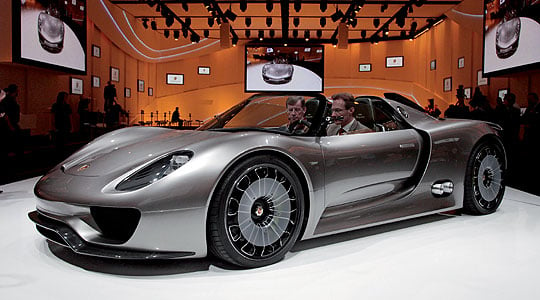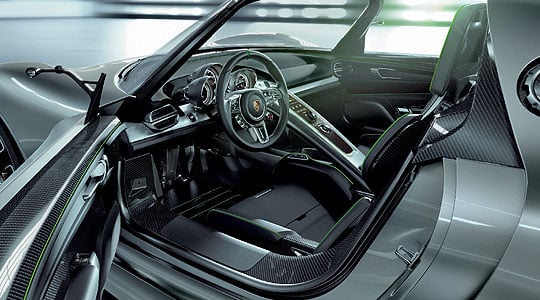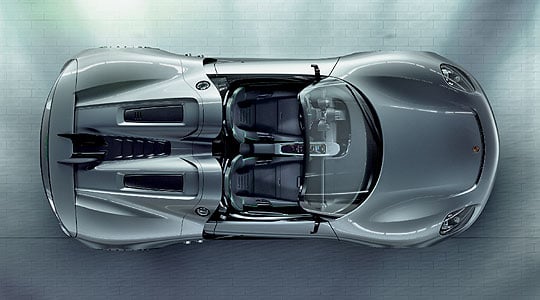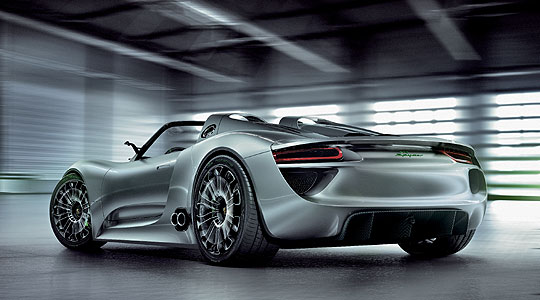
One of the undisputed design highlights of the recent 2010 Geneva show was Porsche’s shock-surprise show car: the Porsche 918 Spyder Concept, writes Chris Hrabalek.
As with the Carrera GT almost a decade earlier, Porsche managed to surprise the car world with a concentrated dosage of Porsche DNA, just as Porsche’s roots seem somewhat diluted (currently with not one, but two four-seat ‘family’ models in the line-up).
The Porsche 918 Spyder is also the perfect answer to save-the-planet panic. The fact that the 718HP 918 Spyder hybrid is claimed to have emissions of only 70g/km – and remembering that the most ecological smart car with 54HP only manages 87g/km – must surely have the mini-Al-Gores choking on their Fairtrade Frappuccinos.
Such impressive statistics didn’t even require Porsche to paint the 918 Spyder eco-green, the solution adopted by their counterparts in Maranello. Certainly, it’s refreshing to imagine all the painfully ugly G-Wizs, complete with ‘you can’t sink a rainbow’ bumper-stickers, being replaced by gorgeous Spyders. It’s good to see that the world can be saved by Manolo Blahniks as well as by Birkenstocks.

The styling of the 918 Spyder is mesmerising. Based on the artwork chassis of the Carrera GT – itself an aesthetical piece fit for any respectable gallery – but featuring a V8 engine instead of a V10, helps the overall proportion of the concept; particularly the rear half of the car. With a volume and stance very much in line with what one would expect of a grown-up Lotus Elise, it was not difficult to win hearts at first glance, and equally not surprising that the concept is thought to be faster round the Nürburgring Nordschleife, with an estimated time of 7min 30sec.
Looking at the styling of the 918 Spyder and finding zero criticisms with regard to volume and proportion, one must take a closer look at the design ‘themes’ and details to find any basis for discussion. The front and rear end of the 918 are very successful and very ‘Porsche’. They both project a perfect balance between quoting the brand’s classics of the past, yet being progressive enough to project the brand’s possible future. In particular, the ‘face’ of the 918 Spyder would be more than welcome on the forthcoming 911 evolution. Similar feelings are evoked at the rear, where clean and geometrical surface treatment still leaves room for voluptuous haunches and indicates a definite evolution to a now almost retro-looking Carrera GT.

Inside the 918 Spyder, it’s a similar success story. Comparing the interior of the decade-old styling of the Carrera GT – which features the same chassis, hence the same ergonomics – the age gap here seems almost double that of the exterior. Gone are history-mimicking details such as wooden gear levers; the overall styling and feel of instruments, switches and graphics are even more contemporary than those found in the Panamera or new Cayenne.
If one were pushed to be overly critical, it’s solely the styling details that feel a bit ‘iffy’. Hubcaps that seem to be recycled from an earlier Volvo ReCharge Concept and side-exiting exhaust pipes that were probably bought in from the administrators of Gemballa, raise an eyebrow or two and the question of whether the Porsche brand really needs this. Probably not. The truth is, the Spyder is such a strong statement – both with regard to design as well as its styling achievement – that the extra 1% ‘show’ did not necessarily give it more ‘go’.

Although one can question whether the future of sports and ‘pleasure’ cars will really be an electric one, or whether we will all wake up one fine morning and find there’s a more realistic answer to the problem, the bottom line remains that the Porsche 918 is a real beauty and, above all, a true Porsche. Please build it: with or without batteries included.

Text: Chris Hrabalek
Photos: Porsche
ClassicInside - The Classic Driver Newsletter
Free Subscription!






